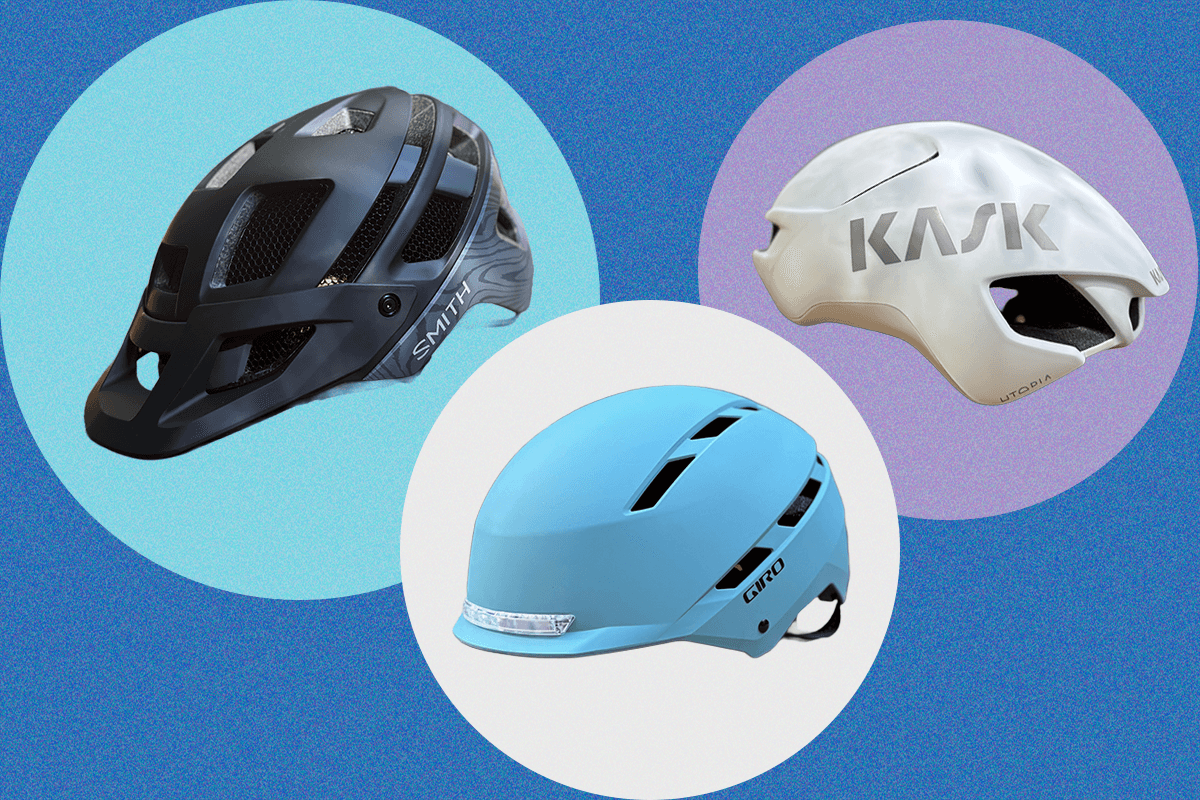All products featured on WIRED are independently selected by our editors. However, we may receive compensation from retailers and/or from purchases of products through these links.
Best Overall
Specialized Align II
Best Everyday Commuter
Thousand Chapter MIPS Helmet
Best Women’s Helmet
Sweet Protection Commuter MIPS
Best Lighted Helmet
Giro Escape Mips Helmet
In the springtime, we all shake off the dusty dregs of winter and pull bikes out of the garage or basement. This is also the time when we start looking at new bike gear, and no piece of equipment is more important than a bike helmet. When worn properly, the best bike helmets can reduce serious head injuries by 60 percent.
I’m a bit of a helmet nut myself. Not just in that I wear one every time I throw my leg over a bike, but I also love variety. I love matching different helmets with different kits and outfits (after all, style goes a long way on the bike), and as a road cyclist, mountain biker, and everyday around-the-town rider, I usually have anywhere from five to 10 helmets at home. Our top picks are the reasonably priced Specialized Align II ($55) and the feature-full Thousand Chapter MIPS helmet ($145).
Here are some of my favorite picks, in a few different categories. Don’t see anything you like? Don’t forget to check out the rest of our outdoor buying guides, including the Best Electric Bikes, the Best Scooters, and the Best Day-Hiking Backpacks.
Most helmets can be broken down into three distinct categories.
A commuter or everyday helmet exists to keep your head safe and little else. Sure, some look cooler than others, some are more ventilated than others, and some offer a bit more comfort than others. But in the end, your everyday helmet puts safety at the fore.
Road helmets take aerodynamics, ventilation, and weight into account. As befits a highly aerobic sport, a road helmet must consider factors like fighting the wind, regulating your body’s temperature, and keeping your neck comfortable, which are essential parts of road cycling.
Mountain biking helmets offer more protection down the back of the skull, are often outfitted with sun-blocking visors (as aerodynamics are far less important on a mountain bike ride), and will sometimes even include clips to fasten eye protection or googles.
You can really get into the weeds with helmets made for gravel riding, downhill or cross-country mountain biking, aero, or full-faced protection. Finally, remember that helmets are not meant to be worn after a crash. Even if the spill is minor and the helmet looks and feels perfectly fine, trash it and get a new one.
The best way to fit your helmet is to try it on. Most helmets today come with a dial system at the rear of the helmet, allowing the rider to adjust their helmets for a more precise fit than ever before.
“Low, level, snug” is the adage to remember when wearing your bike helmet. It should sit level on your head, covering almost all of your forehead. If too much of your forehead is exposed, you’re losing protection in the event of a crash. Your index finger should fit in the space between your eyebrows and your helmet.
The helmet’s strap should be snug enough beneath your chin that you shouldn’t be able to easily fit a finger between your jaw and the strap. You should also not be able to move the helmet more than an inch or so in any direction when it’s secured.
If it’s been a while since you’ve bought your last helmet, you might notice a little yellow sticker on many newer helmets, reading “MIPS,” which stands for “Multi-directional Impact Protection System.” It protects against the rotational motion of the brain during impact, which poses a higher risk of brain damage when compared to direct impact.
While MIPS is the most popular, there are plenty of other companies outfitting helmets with similar systems. MIPS and systems like the 100%’s Smartshock rotational system diffuse the rotational energy of impact.
-
Best Overall
-
Photograph: Michael Venutolo-Mantovani
-
Photograph: Michael Venutolo-Mantovani
-
Photograph: Michael Venutolo-Mantovani
-
Photograph: Michael Venutolo-Mantovani
With all-over ventilation, super light weight, and an easy-on-the-wallet price point, Specialized’s Align II sits at the sweet spot of everyday helmet and road helmet. It’s a one-stop solution for the commuter who likes to get her kicks on the Saturday café ride.
At 365 grams, the Align II is one of the lightest commuter helmets you’ll find. I wore an Align II over a long afternoon spent shuttling my kids from playground to playground on my electric cargo bike. Despite the 85-degree day, my head stayed cool and ventilated. Given the Align II’s crossover appeal as a snug-fitting quasi road helmet, it might work great for anyone needing to show up to the office with well-coiffed hair. At just over $50, you’ll be hard pressed to find a better helmet for the money.
Specs Weight: 365 g for the M/L | Size Range: S/M, M/L, XL | MIPS? Yes -
-
Best Everyday Commuter
-
Photograph: Michael Venutolo-Mantovani
-
Photograph: Michael Venutolo-Mantovani
-
Photograph: Michael Venutolo-Mantovani
-
Photograph: Michael Venutolo-Mantovani
Thousand
Chapter MIPS Helmet
If you’ve ridden a bike to a corner store or bar in the past few years, you’ve seen Thousand helmets. Since they first launched in 2015 with a successful Kickstarter campaign, the brand has become one of the most popular helmets for commuters and everyday riders. That popularity is due in large part to how unassuming they are, but you can still spice it up, as the Chapter comes in plenty of fun color and design combinations.
As I live beneath the hot North Carolina sun, I tend to skew toward light-colored helmets to keep my head from overheating. But the Chapter’s upper vents were able to offset any sense of overheating with a flat black Chapter. It comes with a magnetic rear light that easily snaps off with a gentle pull for recharging. The 30-lumen light will give you visibility from more than 2,600 feet away. But it wasn’t until I arrived at my destination that I noticed the helmet’s coolest feature: a small, punch-out hole through which you can thread a lock to secure your helmet to your bike.
Specs Weight: 370 g for the M | Size Range: S, M, L | MIPS? Yes -
-
Best Women’s Helmet
-
Photograph: Michael Venutolo-Mantovani
-
Photograph: Michael Venutolo-Mantovani
-
Photograph: Michael Venutolo-Mantovani
-
Photograph: Michael Venutolo-Mantovani
Sweet Protection
Commuter MIPS
On my head, the Sweet Protection Commuter MIPS feels more like a road helmet than anything else. It’s a huge, huge plus considering how bulky commuter helmets can often be. According to Sweet Protection’s website, the Commuter is “pony-tail compatible,” which this short-haired writer can’t speak directly to. However, as the helmet’s rear adjustment knob and strap sit quite close to the helmet, I can only assume that leaves plenty of room for longer hair.
At just under 14 ounces, its light weight makes it feel barely there. Its straps fit snug to my cheeks and jaw, skirting another downside of too many everyday helmets. Even though my around-the-town rides rarely last more than an hour, I can easily imagine wearing the Commuter for hours on end with nary an issue of head comfort or neck strain. Like most other everyday helmets, the Commuter is minimally vented. However, its one large forward vent and rear vent did allow plenty of airflow over my scalp as I cruised around Chapel Hill on a sunny afternoon. While it lacks a cool integrated light like the Thousand, it does boast a super reflective strip across the rear of the helmet, giving you more visibility to approaching cars.
Specs Weight: 390 grams | Size Range: S/M, M/L, L/XL | MIPS? Yes -
-
Best Lighted Helmet
-
Photograph: Michael Venutolo-Mantovani
-
Photograph: Michael Venutolo-Mantovani
-
Photograph: Michael Venutolo-Mantovani
-
Photograph: Michael Venutolo-Mantovani
Besides wearing a helmet, one of the safest things you can do while riding a bike is to sport lights. The Giro Escape does some of that legwork for you, as it’s outfitted with USB-rechargeable front and rear lights. This charged me up, as I am a devout light guy. In fact, if you see me on any of my bikes, you might confuse me for one of the runways at LaGuardia International Airport. So, the one-button push to click the lights on and select between steady and flashing was a treat for me.
The Escape is also super comfy and, like the Thousand, unassuming in design. The only downside to the Escape is that megabrand Giro hasn’t quite caught up with the USB-C movement, sticking with an older-school micro-USB port (charging cable included) to charge the helmet’s lights.
Specs Weight: 490 g (medium) | Size Range: S, M, L | MIPS? Yes -
-
Best Aero Helmet
-
Photograph: Michael Venutolo-Mantovani
-
Photograph: Michael Venutolo-Mantovani
-
Photograph: Michael Venutolo-Mantovani
-
Photograph: Michael Venutolo-Mantovani
Talk to any serious road cyclist and you’ll no doubt hear the term “aero.” (Aero is life, according to roadies.) However, one downside of aero helmets is the fact that they shun ventilation in favor of a smooth surface for wind to travel over with ease. Kask makes some of the best helmets in this style that are both aerodynamic and cool (both in temperature and style). All of that comes together on the Italian brand’s Utopia Y helmet, which features tons of well-placed vents across its otherwise smooth surface.
I tested it on a three-hour, 60-mile ride during a sun-drenched and super muggy mid-spring day. The helmet’s retention system made the Utopia Y easily one of the most comfortable helmets I’ve ever worn. At just 260 grams, my neck never felt fatigued. While the Utopia can never be as cool (temperature-wise) as a fully vented helmet, the panoply of air-capturing vents kept my head well short of overheating.
The only issues I had were the fact that the helmet didn’t include any sort of sweat channeling, which led to a few drips in my eyes. The aforementioned retention system also needed readjusting when I took the helmet out on a second, shorter spin later in the week.
Specs Weight: 260 g (medium) | Size Range: S, M, L | MIPS? Yes -
-
Best Ventilated Road Helmet
-
Photograph: Michael Venutolo-Mantovani
-
Photograph: Michael Venutolo-Mantovani
-
Photograph: Michael Venutolo-Mantovani
-
Photograph: Michael Venutolo-Mantovani
Road cycling and spending lots of money tend to go hand-in-hand, which is why it’s refreshing to see a low-sticker road helmet from a brand with as much renown and recognition as Smith. I tested the Persist on the same route as the Utopia, on a similarly sticky day. With more than 20 vents spread across the helmet, my head remained cool and dry throughout the ride. And at just 300 grams, it felt like there was nothing at all sitting on my head.
The Persist also features a combination of MIPS and the energy-absorbing KOROYD system, which gave an added sense of security during the ride. The one issue I encountered with the Persist was that it was a little tough to dial the straps in for a perfect fit. Still, it only took about five minutes of trial-and-error before I had the helmet snug on my skull and the straps tight to my cheeks.
Specs Weight: 300 g (medium) | Size Range: S, M, L, XL | MIPS? Yes -
-
The Safest Helmet
-
Photograph: Michael Venutolo-Mantovani
-
Photograph: Michael Venutolo-Mantovani
-
Photograph: Michael Venutolo-Mantovani
-
Photograph: Michael Venutolo-Mantovani
Giro
Aries Spherical Helmet
Much like the Persist, the Giro Aeries Spherical takes the MIPS system a bit further, combining it with the brand’s new Spherical technology, which is a ball-and-socket design system that redirects energy away from the brain during certain impacts. Basically, think of the helmet as two attached pieces, where the upper dome it able to lightly rotate over the lower part—the part that’s attached to your head—giving you another level of protection.
It also boasts Giro’s new proprietary DryCore system, which redirects sweat away from the forehead (and therefore out of your eyes), toward your temples, where it evaporates more quickly.
Over the same route I tested the other road helmets, I marveled at the Aeries’ barely-there light weight. Weighing in at 275 grams, it felt like I was riding sans helmet. Thanks to the helmet’s massive and numerous vents paired with Giro’s DryCore system, my head never came close to overheating on another hot, sunny, humid day. Like the Kask, the sticker price might be way too high for many. However, if helmets are something you don’t mind dropping coin on, the Aeries is worth every single penny.
Specs Weight: 275 g (medium) | Size Range: S, M, L | MIPS? Yes -
-
The Fastest Road Helmet
-
Photograph: Michael Venutolo-Mantovani
-
Photograph: Michael Venutolo-Mantovani
-
Photograph: Michael Venutolo-Mantovani
-
Photograph: Michael Venutolo-Mantovani
According to megabrand Specialized, their new Propero 4 combines their most aero road helmets with their most ventilated ones. Now, I don’t have access to a wind tunnel, so I can’t confirm Specialized’s claims that the Propero 4 is fifteen seconds faster over 40 kilometers than one of its predecessors, the S-Works Prevail 3.
But I can say that the Propero 4 provided an easy and comfortable fit, with a simple adjustment system that allowed me to find a great fit in a matter of seconds. It also boasts, in addition to three massive front vents, two smaller vents that are dedicated for sunglasses storage. In other words, an exacting place to stick the arms of your riding shades when the sun dips behind the clouds.
And, as looking cool is paramount, I’m happy to report that the test model I tried came in a super interesting blend of matte and gloss white that was only noticeable when viewed up close, which is always a factor in racking up cool points.
Specs Weight: 295 g (medium) | Size Range: S, M, L | MIPS? Yes -
-
A Crash-Sensing Helmet
-
Photograph: Michael Venutolo-Mantovani
-
Photograph: Michael Venutolo-Mantovani
-
Photograph: Michael Venutolo-Mantovani
-
Photograph: Michael Venutolo-Mantovani
Smith
Forefront 2 Mips Aleck Crash Sensor
While crash sensors are starting to become more and more common in helmets of all stripes, they’re still anything but the norm. On its surface, the Smith Forefront 2 looks like your average mountain biking helmet, with a stiff visor, tons of ventilation, and plenty of coverage down the back of the head. Underneath all of that, you’ll find an amazing Aleck Crash Detection Sensor, which, when paired with the Aleck app, sends alerts in the event of crash. It’s the kind of peace of mind that’s well worth the Forefront’s $150 price tag, especially in the more crash-prone world of mountain biking.
It took about five minutes of app downloading and device pairing, after which, I was able to send an invite to my wife, allowing her to “connect” to my helmet and be notified in the event of a crash.
Like the Persist, the Forefront marries a MIPS system and with Koroyd coverage, giving you an added layer of protection. You might think that wearing a helmet with a built-in crash detector feels different. Bulky, perhaps. But the engineers and designers at Smith somehow figured out how to make the Forefront feel like any other mountain bike helmet. With a reported weight of fourteen ounces, it’s one of the lightest and easiest-on-the-neck MTB helmets out there. During my ride on a relatively mild spring day, my head stayed cool, my neck unbothered, and my eyes shielded from the sun, allowing me to fully enjoy the trail system near my home.
Specs Weight: 380 g (medium) | Size Range: S, M, L | MIPS? Yes -
-
Best Mountain Biking Helmet
-
Photograph: Michael Venutolo-Mantovani
-
Photograph: Michael Venutolo-Mantovani
-
Photograph: Michael Venutolo-Mantovani
-
Photograph: Michael Venutolo-Mantovani
100% make some of the best-looking products year after year and their Altis off-road helmet is no different. The Altis boasts plenty of coverage while being super lightweight and full of head-cooling ventilation. It also features 100%’s aforementioned Smartshock Rotational Protective System, which functions exactly the same as the more popular MIPS.
Sometimes, mountain bike helmets can suffer from an issue of bulk. The Altis, however, not only looked sleek and tight; it also felt light on my head. Despite a tricky issue getting the cheek straps positioned properly under my ears, the chinstrap was a cinch, allowing the helmet to fit snug to my jaw and cheekbones (as with commuter helmets, snug-fitting straps are not something often found in mountain bike helmets). All of that combined to give the Altis more of a lightweight road bike helmet feel, as opposed to the more typical heft of a mountain bike helmet. The helmet’s all-over vents also kept my head cool during a recent two-hour trail ride which saw the temperature ticking into the mid-80s.
Specs Weight: 330 g (medium) | Size Range: XS/S, S/M, L/XL | MIPS? Yes -




